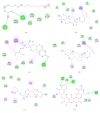Identification of Antidiabetic Metabolites from Paederia foetida L. Twigs by Gas Chromatography-Mass Spectrometry-Based Metabolomics and Molecular Docking Study
- PMID: 31275982
- PMCID: PMC6560335
- DOI: 10.1155/2019/7603125
Identification of Antidiabetic Metabolites from Paederia foetida L. Twigs by Gas Chromatography-Mass Spectrometry-Based Metabolomics and Molecular Docking Study
Abstract
Paederia foetida L. (Rubiaceae) is a climber which is widely distributed in Asian countries including Malaysia. The plant is traditionally used to treat various diseases including diabetes. This study is to evaluate the enzymatic inhibition activity of Paederia foetida twigs extracts and to identify the metabolites responsible for the bioactivity by gas chromatography-mass spectrometry (GC-MS) metabolomics profiling. Three different twig extracts, namely, hexane (PFH), chloroform (PFC), and methanol (PFM), were submerged for their α-amylase and α-glucosidase inhibition potential in 5 replicates for each. Results obtained from the loading column scatter plot of orthogonal partial least square (OPLS) model revealed the presence of 12 bioactive compounds, namely, dl-α-tocopherol, n-hexadecanoic acid, 2-hexyl-1-decanol, stigmastanol, 2-nonadecanone, cholest-8(14)-en-3-ol, 4,4-dimethyl-, (3β,5α)-, stigmast-4-en-3-one, stigmasterol, 1-ethyl-1-tetradecyloxy-1-silacyclohexane, ɣ-sitosterol, stigmast-7-en-3-ol, (3β,5α,24S)-, and α-monostearin. In silico molecular docking was carried out using the crystal structure α-amylase (PDB ID: 4W93) and α-glucosidase (PDB ID: 3WY1). α-Amylase-n-hexadecanoic acid exhibited the lowest binding energy of -2.28 kcal/mol with two hydrogen bonds residue, namely, LYS178 and TYR174, along with hydrophobic interactions involving PRO140, TRP134, SER132, ASP135, and LYS172. The binding interactions of α-glucosidase-n-hexadecanoic acid complex ligand also showed the lowest binding energy among 5 major compounds with the energy value of -4.04 kcal/mol. The complex consists of one hydrogen bond interacting residue, ARG437, and hydrophobic interactions with ALA444, ASP141, GLN438, GLU432, GLY374, LEU373, LEU433, LYS352, PRO347, THR445, HIS348, and PRO351. The study provides informative data on the potential antidiabetic inhibitors identified in Paederia foetida twigs, indicating the plant has the therapeutic effect properties to manage diabetes.
Figures









Similar articles
-
Comparative study of the antidiabetic potential of Paederia foetida twig extracts and compounds from two different locations in Malaysia.Pharm Biol. 2019 Dec;57(1):345-354. doi: 10.1080/13880209.2019.1610462. Pharm Biol. 2019. PMID: 31185767 Free PMC article.
-
Characterization of α-Glucosidase Inhibitors from Clinacanthus nutans Lindau Leaves by Gas Chromatography-Mass Spectrometry-Based Metabolomics and Molecular Docking Simulation.Molecules. 2018 Sep 19;23(9):2402. doi: 10.3390/molecules23092402. Molecules. 2018. PMID: 30235889 Free PMC article.
-
Investigation of α-Glucosidase Inhibitory Metabolites from Tetracera scandens Leaves by GC-MS Metabolite Profiling and Docking Studies.Biomolecules. 2020 Feb 12;10(2):287. doi: 10.3390/biom10020287. Biomolecules. 2020. PMID: 32059529 Free PMC article.
-
A delve into the pharmacological targets and biological mechanisms of Paederia foetida Linn.: a rather invaluable traditional medicinal plant.Naunyn Schmiedebergs Arch Pharmacol. 2023 Oct;396(10):2217-2240. doi: 10.1007/s00210-023-02496-4. Epub 2023 Apr 26. Naunyn Schmiedebergs Arch Pharmacol. 2023. PMID: 37099165 Review.
-
GC-MS analysis, molecular docking, and pharmacokinetic studies of Multidentia crassa extracts' compounds for analgesic and anti-inflammatory activities in dentistry.Sci Rep. 2024 Jan 22;14(1):1876. doi: 10.1038/s41598-023-47737-x. Sci Rep. 2024. PMID: 38253619 Free PMC article. Review.
Cited by
-
GC-MS- and NMR-Based Metabolomics and Molecular Docking Reveal the Potential Alpha-Glucosidase Inhibitors from Psychotria malayana Jack Leaves.Pharmaceuticals (Basel). 2021 Sep 26;14(10):978. doi: 10.3390/ph14100978. Pharmaceuticals (Basel). 2021. PMID: 34681203 Free PMC article.
-
Assessment of antidiabetic potential and phytochemical profiling of Rhazya stricta root extracts.BMC Complement Med Ther. 2020 Sep 29;20(1):293. doi: 10.1186/s12906-020-03035-x. BMC Complement Med Ther. 2020. PMID: 32993632 Free PMC article.
-
Profiling of secondary metabolite and evaluation of anti-diabetic potency of Crotalaria quinquefolia (L): In-vitro, in-vivo, and in-silico approaches.Saudi Pharm J. 2024 Jan;32(1):101887. doi: 10.1016/j.jsps.2023.101887. Epub 2023 Nov 25. Saudi Pharm J. 2024. PMID: 38090734 Free PMC article.
-
Rapid Quantification and Validation of Biomarker Scopoletin in Paederia foetida by qNMR and UV-Vis for Herbal Preparation.Molecules. 2020 Nov 6;25(21):5162. doi: 10.3390/molecules25215162. Molecules. 2020. PMID: 33171900 Free PMC article.
-
Antinociceptive and Anti-Inflammatory Activities of Acetonic Extract from Bougainvillea x buttiana (var. Rose).Pharmaceuticals (Basel). 2024 Aug 6;17(8):1037. doi: 10.3390/ph17081037. Pharmaceuticals (Basel). 2024. PMID: 39204142 Free PMC article.
References
-
- World Health Organization. Global Report on Diabetes. World Health Organization; 2016.
-
- Ahmed A. A., Islam M. M., Rahman M. A., Hossain M. A. Thrombolytic, cytotoxic and antidiabetic effects of Paederia foetida L. leaf extract. British Journal of Medicine & Medical Research. 2014;4(5):1244–1256.
-
- Upadhyaya S. Screening of phytochemicals, nutritional status, antioxidant and antimicrobial activity of Paederia foetida Linn. from different localities of Assam, India. Journal of Pharmacy Research. 2013;7(1):139–141. doi: 10.1016/j.jopr.2013.01.015. - DOI
MeSH terms
Substances
LinkOut - more resources
Full Text Sources
Medical
Research Materials
Miscellaneous

